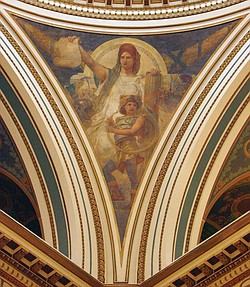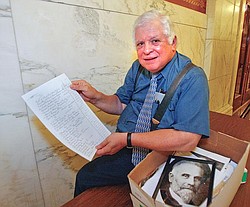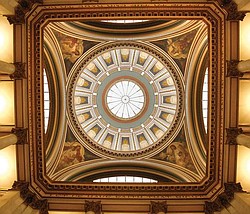Book tells history behind Mahoning rotunda murals
LAW OF THE LAND: Edwin Blashfield painted pendentive murals such as this depicting the evolution of law for the Mahoning County Courthouse in 1911.
UNOFFICIAL HISTORIAN: Ed Black, an employee in the Mahoning County Clerk of Courts office, has a file box full of Blashfield relics, including photos, copies of handwritten letters and price ledgers. The county commissioned Blashfield to paint a mural for the courthouse ceiling for $10,000.
LAW OF THE LAND: Edwin Blashfield painted pendentive murals such as this depicting the evolution of law for the Mahoning County Courthouse in 1911.
By RICK ROUAN
VINDICATOR STAFF WRITER
The Mahoning County Courthouse rotunda murals, once yellowed by the smoke of the city’s steel mills and cigar-toting lawyers, will appear next month in a book of essays about the famous artist who painted them.
On Sept. 28, Norton Books for Architects and Designers and the Institute of Classical Architecture will publish a book about Edwin Howland Blashfield, a late-19th- century New York muralist whose work still stands in Rockefeller Center, St. Matthews Cathedral and the Mahoning County Courthouse.
The murals, completed in 1911, depict the four periods in the evolution of American law from biblical times to modernity.
“It’s very beautiful. I think, because the courthouse is such a stunning building in your city, that there may be some curiosity about what’s inside that building and how it came to be,” said Mina Weiner, editor of “Edwin Howland Blashfield: Master American Muralist.”
The book contains four essays by four authors, including Weiner. The essays cover historical perspectives on the artist, interpretations of Blashfield’s art, his methodology and his influence today.
Paramount to Blashfield’s work was the idea the building’s architect wished to convey, Weiner said.
“He felt the architect was like a general in an army, and he had a vision of the project, and everyone involved was to fulfill that particular mission,” she said.
Weiner said that Blashfield’s philosophy was shaped by his tour of Europe, where he studied, and that he believed in art that “every man could see.”
“We do go into the courthouses and admire them,” she said. “Unfortunately, economics is everything. The first thing that goes is something pretty.”
When Blashfield completed the murals in 1911, he was paid $10,000 by Mahoning County, said Ed Black, an employee in the clerk of courts office who is known as the unofficial historian of the courthouse.
Black said he began keeping a box of historical memorabilia — newspaper clippings, photos, copies of handwritten letters the artist wrote — in the late 1980s, when the courthouse was renovated.
The $8 million renovation project included restoration of courthouse murals by John Benninger and Phyllis Beard.
“They had people go up and clean them off because they had a yellow stain from cigar and mill smoke coming in from the windows,” Black said.
rrouan@vindy.com
 43
43



